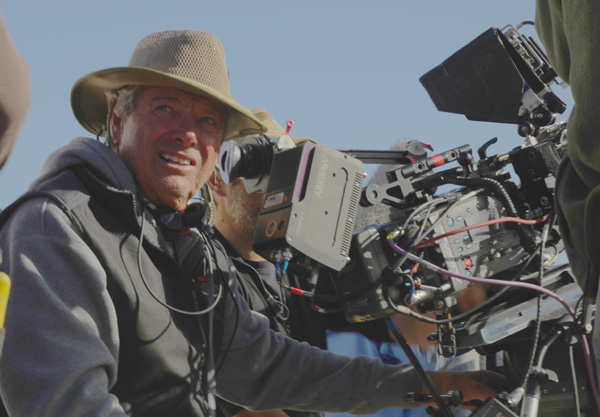John Seale ASC ACS and his intrepid crew followed Furiosa’s War Rig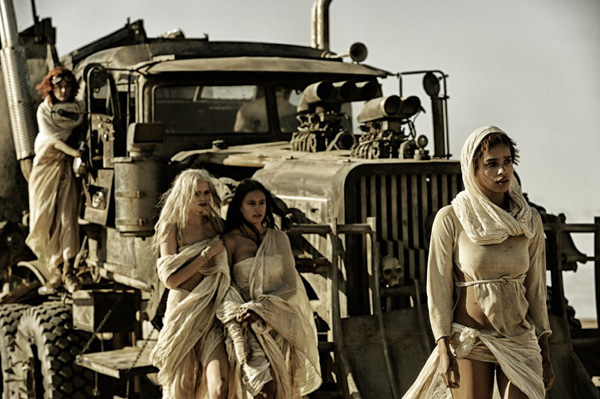
across the Namibian desert to capture ‘Mad Max: Fury Road’ with 6
ARRI ALEXA cameras and 11 Codex onboard recorders.
Cinematographer John Seale Rolls Down ‘Fury Road’ |
| ‘Mad Max: Fury Road’, the fourth movie in director George Miller’s series of post-apocalyptic action movies, is the first digital film that cinematographerJohn Seale ASC ACShas shot. During his career of more than 30 years he has filmed movies including ‘The Mosquito Coast’, ‘Witness’, ‘Dead Poets Society’ and ‘Rain Man’. In this interview with Digital Media World, John describes his experiences working on the set of ‘Fury Road’. |
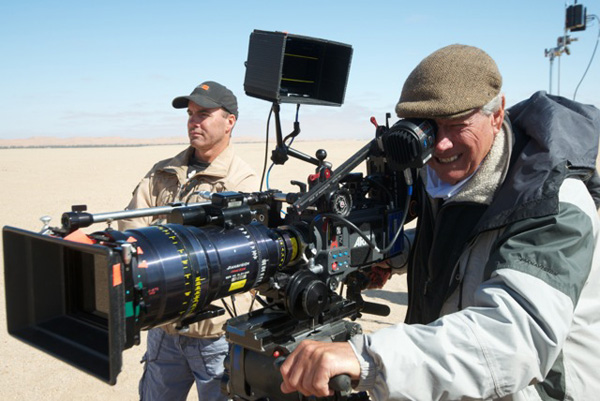 |
|
As the shoot approached, the outback region in New South Wales, Australia near Broken Hill, where George Miller had originally wanted to shoot the movie, had experienced several unusually wet years and was blooming, making it unsuitable for the desired wasteland setting. The coastal deserts of Namibia, on the other hand, are among the most severe and visually striking in the world, where sand dunes measure nearly 1000m high and 30km long. |
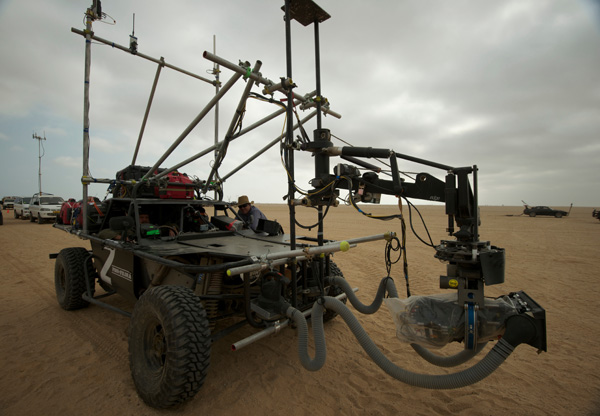 |
Digital Deep EndAfter the decision was made to relocate, the whole production prepared for the region’s inhospitable conditions, which include frequent sandstorms and intense heat, while John and the crew focussed on the cameras. “By the time I came on board the show, George and Paul Nichola, a cinematographer and visual effects specialist, had spent the previous three years building their own 3D cameras from scratch,” he said. “The fact that I had never shot a digital film before, let alone in 3D, meant I was thrown in at the deep end of the digital world. Dean had been testing these cameras in the desert and still solving problems when I got involved. It was daunting to say the least. There were heating issues, reflection challenges and many other small problems to contend with. “What I quickly recognized from looking at Dean’s lighting tests was that the chip did not have a great range, which was problematic when balancing the lighting of Furiosa’s War Rig interior with the desert exteriors – a major issue. However, one Monday morning George arrived at the ‘Fury Road’ crew meeting and declared, ‘We are going 2D.’” |
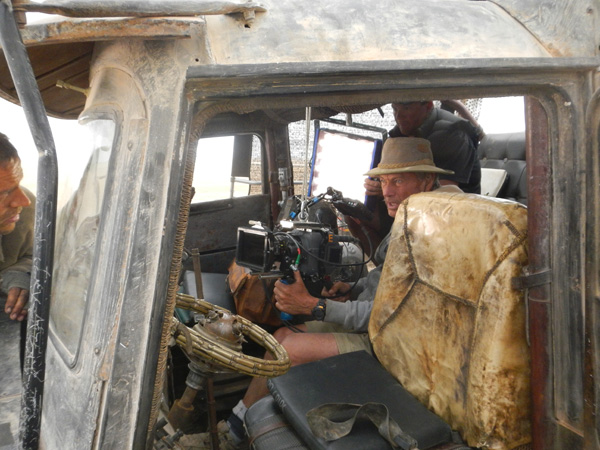 |
|
“Despite my own film background, film cameras were never mentioned. I believe that George’s visual brain was locked into the digital revolution, and there it was to remain. Warner Bros also agreed to post-converting the footage to stereo and, interestingly, we didn’t have to give that aspect of the production any consideration during our 2D coverage.” Road Crew and KitJohn worked with a talented crew who came with a lot of experience, not just on digital shoots but in deserts and jungles, in dry, hot, wet, moist environments – whatever the situation demanded. He has shot many film-negative films under severe conditions himself, but never digital, and was initially a bit worried. However, the crew was well-prepared and put together full precautionary kits of rain and dust covers and protection to take the heat off the cameras in the middle of the day. |
 |
|
The relatively large number of cameras and recorders helped the camera crew remain nimble on the mobile shoot. While one scene was being shot, the next was being prepped. Thecamera coordinator Michelle Pizanissaid, “We kept two cameras and two extra high vehicles rigged the whole time. When we drove up to a location, we could start shooting straightaway rather than breaking the cameras down at one site and rebuilding them at the next.” Michelle and the1st assistant cameraman Ricky Schamburgwent to Los Angeles to sort out the kit and disposables for the shoot, and found some very small prime 15/16 mm lenses. “I’ve been shooting with zoom lenses for 20 years,” John said. “Our lens specialist at Panavision, Dan Sasaki, re-calibrated them to bring the hyperfocal depth of field forward, so that the image from the front element out to about 8ft away, could be kept sharp at all times. They were fabulous little lenses and worked perfectly in the cab of the War Rig, making the ALEXA M cameras a very compact unit. |
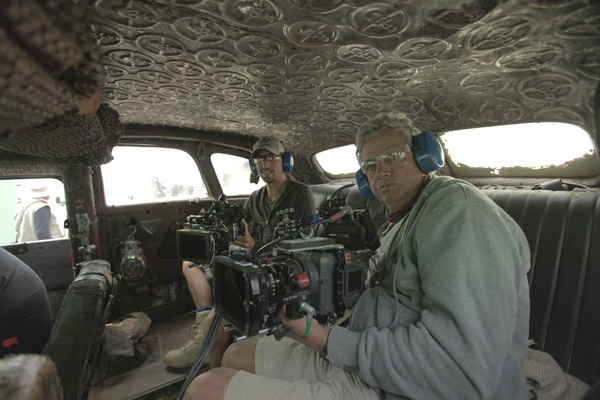  |
|
Bold FilmmakingThe ‘Mad Max’ series is distinctive for its gritty mood and atmosphere, but Fury Road went for a different look and makes heavy use of visual effects. “The DI and post work is so explicit - almost every shot was going to be manipulated in some way,” John said. “Our edict was ‘just shoot it.’ Continuity of light wasn’t really a question. We knew that the film would be cut very quickly, so there wouldn’t be time to analyze every shot, and intercutting between overcast and full sun wasn’t going to be a problem. On this film, the end result controlled the execution. “George has a very intensive knowledge of digital imaging, gained through working on his animated films, and knew he could combine live action imagery with digital elements in post to get the look he wanted. He is a bold film maker in every respect, and the visual presentation in ‘Mad Max’ was to be a big part of that boldness. The project had been nurtured over several years, so by the time we were actually shooting, he could simply cut the shot once he had captured what he needed for the edit, and go no further. This can be very frustrating for many of the people involved - including the actors, camera operators and so on - but that’s just how positive and confident George could be. |
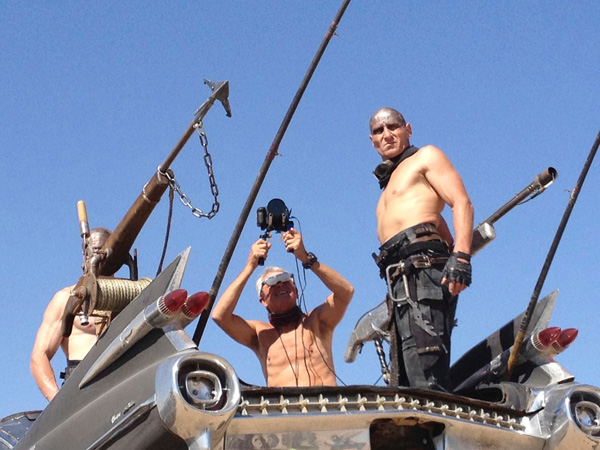 |
Continuity and Confidence“The lack of consistency in the weather never worried us either because the image was going to be so extensively manipulated in terms of colour, density and grain, and edited fast enough to take care of any continuity problems. As George said himself, ‘If the audience has time to find a mistake, then the shot is too long.’ Nevertheless, I was someone who had gone through a full career instigating continuity of light. In the course of a single project, I suddenly realised that a production no longer has to work under those restrictions. “Having a visionary like George take you there, with all confidence, to his final vision of the film was an awesome experience. I did worry about that continuity, but being able to believe in George’s confidence enabled me to become one of the camera operators in the group. Since I had spent years as a DP and operator as well and always enjoyed it, it was easy to slip into that role again.” George had maintained from the beginning that the film would be a truck ride and chase that would not stop for the duration of the story. He also talked of how fast he would cut, even at the risk of continuity. In his mind, the whole premise of the movie was a sleigh ride where no one gets off. |
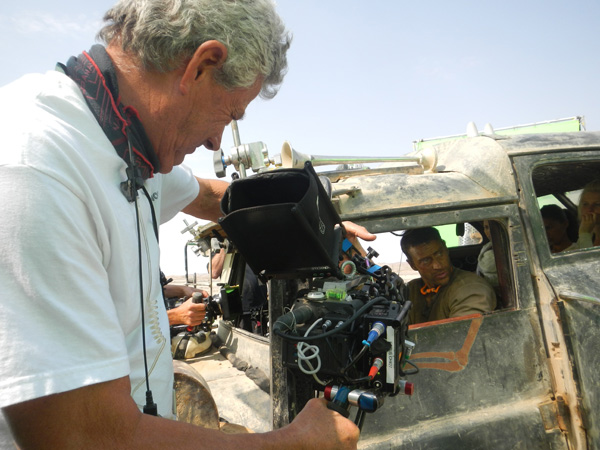 |
|
Shooting for PostAlthough John knew the essentials of the upcoming post and DI that ‘Mad Max’ would undergo, he wasn’t fully aware of exactly how far the process would go until they started shooting and George explained to him how some shots would be integrated with the visual effects. It didn’t take long for him to realize that the post would be very substantial, would include the ability to shoot in any weather and, in fact, would disregard almost anything he had ever learned about putting the final image on the negative. He and his crew chose to record ARRIRAW in order to output maximum image quality and flexibility for post manipulation, and used the Codex recorders, which were the only type capable of reliably capturing ARRIRAW at that time. “The choice to go with Codex was definitely for the quality of the recording and post-production considerations,” John said. |
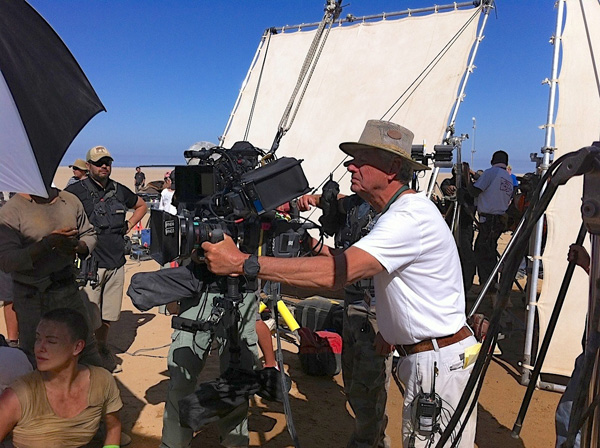 |
|
Reversing Day-for-Night“For example, we had plans to capture night shoots, but because it was freezing and windy and we had massive areas to light, we opted for a day-for-night approach. There wasn’t a lot of information available on procedures for shooting a digital day-for-night sequence, so we made the decision to just shoot as best we could, and fix the results in post. “Where it got interesting was when the VFX team asked us to overexpose the material by two stops, which is totally opposite to the way I would have approached the task after 45 years filmmaking. As usual, however, the team’s reasoning was very logical. If we overexposed into the shadow areas, they would print down to a desired moonlight density. Then, if they wanted to rotoscope within the frame area they could print that part up without producing digital noise.” |
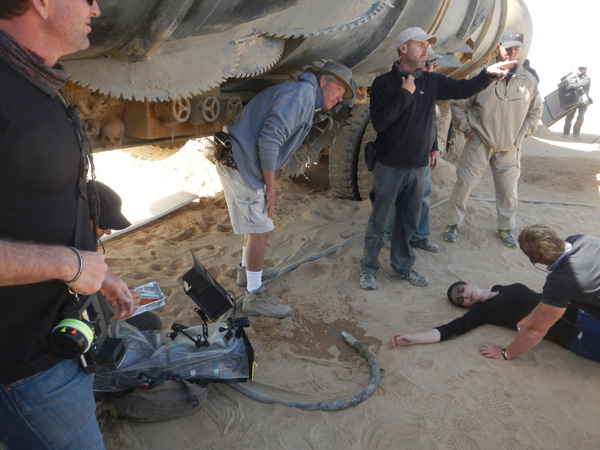 |
|
“I think the way digital has moved ahead is extraordinary. Its R&D is vertical, specialised, while film development has stopped. The ability of digital to record images coupled with the DI, where you can change and manipulate the looks, allows you do almost anything you like.” ParaphernaliaShooting digitally with Codex had another advantage over shooting on film in that it avoided the need to reload cameras with film negative in the blowing winds of the desert. “As mentioned, we were a little worried about desert extremes of heat and cold because the temperature changes so much from night to day. We had dust storms, with dust flying everywhere, and sometimes had moisture in the air and needed to protect the Codex recorders from heat and sand. Their electronics also tended to overheat and had to be encased in padding for shocks.” |
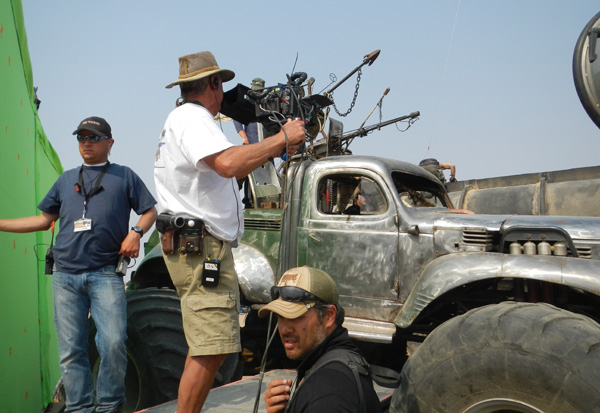 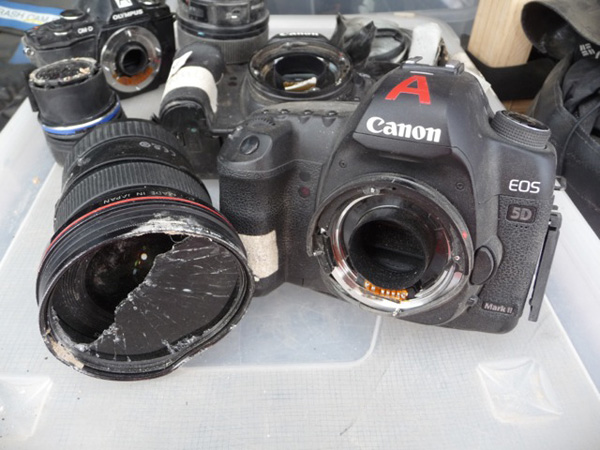 |
|
“I believe that in any big action picture in which the VFX and the DI have a major visual impact, cinematographers need to be as collaborative as possible in our input to the production, and in our acceptance of the massive import those other departments have for the project. The contribution of ourcolourist Eric Whipp, for example, who was on the show for eight months working hand in hand with George and the VFX departments, was invaluable to the looks of the movie. The final grading of the film is a credit to him.” Video VillagesOn the set in Namibia, George Miller had the benefit of an equipment and communications infrastructure he could use to review shots and even edit material to determine what further coverage was needed. RF interfaces were used with the ALEXA cameras to transmit images. Michelle Pizanis described the set-up. “A company based in Sydney calledLateral Linkingdesigned the complete RF infrastructure in Namibia,” she said. “They had set up towers throughout our shooting path to be able to transmit a signal to the numerous video villages.” |
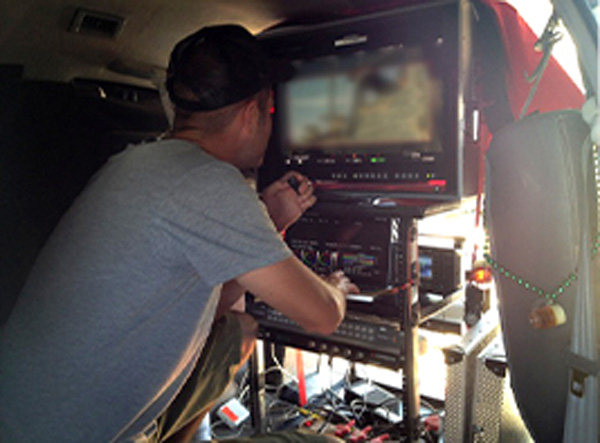 |
| DIT Marc-Jason Maier monitors looks on the dailies from the ALEXAs. |
|
“We were shooting RAW onto theCodex CDX3010onboard recorders, and Pro Res onto the SXS cards as a back up. Our editorial team then provided dailies on the iPads - we had several that we used in rotation. John choose to have his show a one light image with no looks, while others preferred to have a rendered LUT look established. This was also monitored and controlled by theDIT, Marc-Jason Maier.” |
|
|
|
“George had arranged a dedicated LUT for us to use on the images on the set, although it wasn’t necessarily going to be the final look.Jason Boland, our on-set stills photographer, would often manipulate images on his computer for George to look at, which I thought looked great. He cranked up the grain, focus, colour and contrast, heading the image in a very interesting direction. It still wouldn’t be the final result, though.” |


